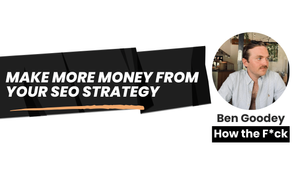Want your SEO strategy to make you more money?
There’s one big, not-so-simple, trick that can make yours:
- More powerful
- More effective
- More profitable
What’s the trick?
Well, it’s not a quick trick at all. Sorry.
To squeeze more profit out of your SEO, we need to revisit some important marketing fundamentals.
Let's dive in.
The first time they hear about you ideally isn't your bottom-of-funnel listicle
I'm just gonna say it.
If you sell a B2B product/service and target senior-level audiences with an expensive purchase, there’s a low likelihood that your ideal persona (say, a senior director at any firm) is going to stumble onto your brand for the very first time on Google and make a buying decision in your favour.
Let me illustrate this with a short scenario:
Imagine you’re a senior marketing leader at a company with 1,000 or so employees. You’re using Salesforce as your CRM and everyone’s complaining about it, they want to switch.
It’s a big decision, a big change, and costs over $2M/year, so naturally you’ve been putting it off for a couple of years now.
But it has finally become the time. You’ve found the space on the roadmap and you’re gonna make the shift away from Salesforce in the next 6 months.
During the time you’ve been delaying this procurement, you’ve:
- Been to an industry event where Hubspot spoke
- Seen the Hubspot founder posting on LinkedIn
- Downloaded a Hubspot eBook, with something useful in it
- Have received Hubspot emails and invites ever since
- And have been getting Hubspot ads
Now, with the goal of creating a list of 7 providers to book a call with, you kick off your research by Googling:
“Best CRM software”
And you click the first listicle that appears.
It’s some random site you haven’t heard of before, RandomX
On that list of "best CRM software" you find:
- RandomX
- Hubspot
- Salesforce
- Zendesk
- Keap
- Zoho
- Apptivo
- SugarCRM
You click on a few more listicles and find a similar list, but RandomX isn’t mentioned.
You ask a Slack group and get a similar list of recommendations, but RandomX isn’t mentioned.
You never think about RandomX again.
But, I predict there's 110% chance you are going to book a demo of Hubspot and probably a few others that were mentioned in the listicles (and you’d seen multiple times).
The end.
Okay, just kidding, it’s not the end, but I hope my point is becoming clear.
So many unknown SaaS companies think they can get away with it.
- Zero brand awareness
- Zero product awareness
- Zero credibility or trust
Then, 100% focus on bottom-of-funnel SEO—competing against huge names (often with their pretty badly designed website).
That's not to say that doesn't work ever.
It does sometimes.
Especially if your decision journey is shorter, easier, less risky or more impulsive, or your competition weak, like these:
- A mobile app
- A freemium project management tool
- A social media calendar app
- A local accountant (they have pretty uniform offerings)
- An innovative tech where all competing options are just as small-brand as you
Then you can get away with it a bit more.
Your ICP can take the risk and test your product without serious commitment—probably through a free trial, $10/month out of their own wallet, or an hour of their time.
But still, even then, BOFU content will be much less effective than if you had a brand that your ICP interacted with multiple times before.
Luckily, with B2B SEO, the higher traffic opportunities are typically in the awareness and consideration phases of this customer journey. This is fun because we can scale and build lots of traffic.
The lower-volume traffic opportunities are typically in the “conversion” or “high intent” phase.
This is the drips of traffic that turn into 95% of your customers.
With B2C SEO, this relationship often flips.
The intersection of the customer journey and Google search has a completely different makeup in B2C.
Imagine a headphone brand. 95% of the demand generation (which happens in the awareness phase) happens via:
- TV/YouTube advertising
- Paid campaigns
- Influencer partnerships
The market adoption for headphone tech is in the late stages—everybody already knows “what is a headphone?” and is well aware of the benefits, thus this search term has close to zero traffic.
Whereas, the commercial-intent term—people looking to buy headphones by Googling “headphones”—has close to 1 million monthly searches.
Despite this completely different market makeup, the customer journey scenario still stands here.
Even if the brand RandomY ranked #1 for “headphones”, 95% of that commercial demand is likely to filter to Apple, Beats, and Bose.
We know them. We trust them. We already want them.
So, this is how you make your SEO strategy make more money.
Create more touchpoints with a holistic marketing strategy.
Be everywhere.
Add these channels to the mix:
- Social media
- Paid ads
- Paid retargeting of TOFU traffic
- Brand campaigns & partnerships
- Podcast appearances
- Top AND bottom-funnel SEO
And, importantly, when they’re ready to make that buying decision—you better also appear at the top of Google, or someone else will snatch the win.
—Benny


